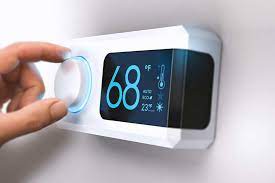The HVAC system is one of the primary power consumers in a home.
To reduce monthly electricity bills, some people turn off ACs when not in use and turn them on when in use.
But does turning AC on and off cost more or save power? Read on to find out the truth to this.
Homeowners can visit Anderson Air for more expert information on their AC unit cycles and more.
The ‘on” and “off” settings of an AC
Before we proceed, what exactly is to turn on and off an AC?
Turn “On” is also known as the On setting, while turn “off” is the Auto setting.
On setting
This means that your AC stays active 24 hours a day.
Auto setting
This means your AC turns itself off with the whole cooling system when it attains the temperature on your thermostat.
When the “On” setting is costs less
Does turning the AC on and off cost more money in the long run? Some people say that turning on and off (Auto) your air conditioner actually costs more. The reasoning is that when you switch off your AC, the system completely shuts off.
Although doing this saves you power through the day when you are not home, it costs more in the long run. This is because when you turn on your AC again, the AC’s system uses more power to turn on and work properly.
So, they say that leaving your AC throughout the day (On) will save more power as your AC system doesn’t have to use more energy every single time you turn it on.
The “on” setting is cheaper in the summer
Having the fan “on” costs less in the summer.
Turning off your AC during summer (when temperatures are high because you won’t be home) increases the temperature and humidity in your home. So when you return home and turn it on again, your AC has to work harder to lower the high temperature to a cooler temperature. And this doesn’t happen immediately.
The AC has to push its limits for a longer time than usual to give you a comfortable temperature, utilizing more electricity. It also puts too much strain on it, leading to frequent breakdowns and repairs, which leads to less efficient cooling and high energy bills.

When the “Off” setting costs less
Does turning your AC on and off cost more? Although turning your AC on and off uses more energy, it can be cheaper in the long run. Why is this so?
A fan or AC set on “On” cycles that are 200 hours more in a month use more energy than a fan set to “Auto.” So, a fan or AC on “on” costs more in the long run.
On top of that, this AC is more likely to freeze up when left on the “On” setting.
Why is this so? When ACs suck in unfiltered air, they draw out the water in this air. When clean, dry air is released into your home, the moisture or water remains in your cooling system’s coils. So when the fan is on “Auto,” it shuts off when it reaches the preset temperature. This gives your AC time to cool off, allowing the frozen water in its coils to liquefy and drip off into the drain pan, preventing the AC from freezing.
On the other hand, when the AC is on the “On” setting, there is no time for the AC to shut down, to stop sucking in air, and for the water to drip off into the drain pan. This leads to a continuous buildup of moisture in the coils. And what happens is that some of this moisture ends up being blown back into the air and what remains freezes in the coils of the AC, causing blockage and AC malfunction.
Most efficient AC systems maximum dehumidify air when they have a goal to meet. When you turn off your AC and turn it back on, it runs at full speed. And this is where it is most efficient.
So, turning the AC on and off costs less in the long run.
Which costs more: on or off?
Does turning AC on and off cost more?
From the explanations above, both sides have their benefits and demerits. In the long run, turning your AC on costs more.
But this option will not provide you with the perfect atmosphere when you return home. So the perfect solution is to meet halfway, as you can see below.
Use a programmable thermostat to reduce your bills
Although leaving your air conditioner on all day is not economical, it ensures that you come back to a home with comfortable indoor air quality and temperature. So how do you maintain this balance? By using a smart programmable thermostat.
Instead of your AC running at maximum efficiency throughout the day while consuming a lot of power, the smart/programmable thermostat allows you to program your AC so that it adjusts to a set temperature at different times of the day.
Say, if you leave home the whole day and return in the evening or at night, don’t shut off your AC or leave it on the whole day while you are away. Instead, you can adjust or set your smart thermostat to increase or decrease the temperature while you are away.
This will not only give you a comfortable home when you come back, but it will reduce your electricity costs and increase the lifespan of your AC as there is less wear and tear on it.
Conclusion
The question “does turning on and off the AC cost more?” should actually be “how do you use an AC efficiently?”.
The more efficient an AC is, the more it saves on power. And you can only know how to operate your AC efficiently with the help of an HVAC expert. They will analyze your property, list your cooling needs, and advise you on the best AC that meets your needs and how best to use it. Doing this helps you ensure your AC runs efficiently, reducing your costs in the long run.




